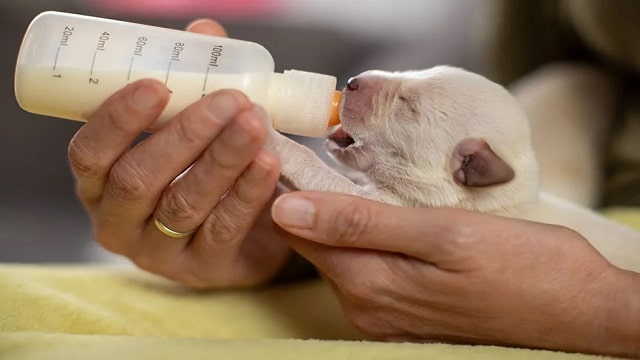The food a dog eats during the first months of its life is essential for its subsequent mental and physical development.
The day has finally arrived! The puppy arrives home. It’s all games and affection until one of the main doubts arises: what does a puppy eat? Having these doubts is completely normal, so you should take note of the following advice so that your pet is properly fed from birth. The diet of a newborn puppy varies as the months go by, but it is always necessary to provide the animal with all the necessary nutrients for its subsequent development into adulthood.
Breast milk for the newborn dog
From birth until the first month or so, the ideal is for the newborn to be fed with the mother’s milk. This is the so-called suckling phase. In addition, drinking milk from its mother will help it in the future in terms of health and also in social relationships, since the first social bond of a newborn dog is established with its mother.
Therefore, it is best to wait until the dog has completed this breastfeeding phase before taking it home. However, if the newborn dog is an orphan or it is simply impossible for the mother to breastfeed it, it will be necessary to give it milk with a bottle until it is at least approximately one month old.
The type of milk that humans consume is not suitable for a puppy, nor is any type of bottle suitable. Both must be specific for puppies. Luckily, both are easy to find in veterinary clinics or specialized stores. When giving the bottle, the time that must pass between feedings will be about four or five hours.
It is very important to monitor the puppy’s digestion. This way, you can make sure that after drinking milk, the puppy does its business. If the dog has diarrhea or constipation, you should consult your veterinarian to find out what is happening.
The change to croquettes
When a dog is one month old, teeth start to come out. It is the perfect time to make the transition from liquid to solid food. A good idea to make this step easier for the puppy is to hand him the new food, let him come close and smell it and finally eat it. Another idea to make the new food more attractive for puppies is to moisten the food with milk, so that chewing does not become cumbersome for the dog.
In this regard, it is worth noting that veterinarians and experts remind us that it is preferable to use quality brand dog food, as it contributes to better mental and physical development for the dog. When the dog eats the food, it should be congratulated or shown that it is doing the right thing. Other measures to improve a puppy’s eating behavior include approaching it and petting it and getting it used to eating times that generally should not coincide with human meals, but rather afterward.
False myths about dog food
There are many myths and false beliefs about feeding dogs in general, and puppies in particular. For example, that dogs get bored of always eating the same thing. Many experts believe that this is not the case, since “dogs hardly taste the food, they don’t enjoy it, they gobble it up simply by smell,” as Sonia Ferrer, a dog trainer, points out. Thus, we must defend the consumption of feed or kibble over leftovers or, even worse, food cooked exclusively for puppies.
The idea of the dog with the bone is always present in the popular imagination. It is really necessary to avoid dogs eating bones because, although it is true that they like them, they can cause choking problems if a small piece of bone moves inside the dog. You have to be very careful in this regard to avoid scares with your pet.
Forbidden foods
In addition, there are a number of food products that are highly recommended for humans but are not at all recommended for dogs, especially when they are small.
- The high sugar content of sweets can promote the onset of diabetes in dogs, the most visible sign of which is total blindness.
- The composition of cocoa (chocolate) includes an enzyme that is impossible for the canine stomach to digest, so chocolate practically becomes a poison for the dog, even causing death.
- Grapes, raisins, nuts, and avocados also have a bad effect on a dog’s digestive system due to their composition, which is harmless to humans but very harmful to puppies.
In this case, the simplicity of a dry food diet is the healthiest option for a puppy, and you don’t have to overcomplicate things when feeding your pet. The most important thing is that your puppy is properly fed and doesn’t lack the most necessary nutrients.

